Dissertation: Factors Influencing Hong Kong Student Destination Choice
VerifiedAdded on 2022/11/26
|74
|11906
|300
Thesis and Dissertation
AI Summary
This dissertation chapter outlines the research methodology employed to investigate the factors influencing the destination choices of local university students in Hong Kong for their overseas holidays. The study utilizes a quantitative approach, specifically a survey, to gather data on student preferences, travel patterns, and the importance of various destination attributes. The research philosophy adopted is positivism, and the research approach is deductive, employing a descriptive research design. The primary quantitative strategy involves collecting data through a questionnaire distributed to a sample of 385 students, selected using a non-probability sampling technique. The chapter details the rationale for these methodological choices, including the justification for the research philosophy, approach, design, strategy, and sampling techniques. The study aims to understand the impact of demographic backgrounds on destination choices and to identify the key factors that influence these decisions, providing valuable insights into the travel behavior of Hong Kong university students. The chapter also provides details on the data collection techniques, ensuring that the research objectives are met.
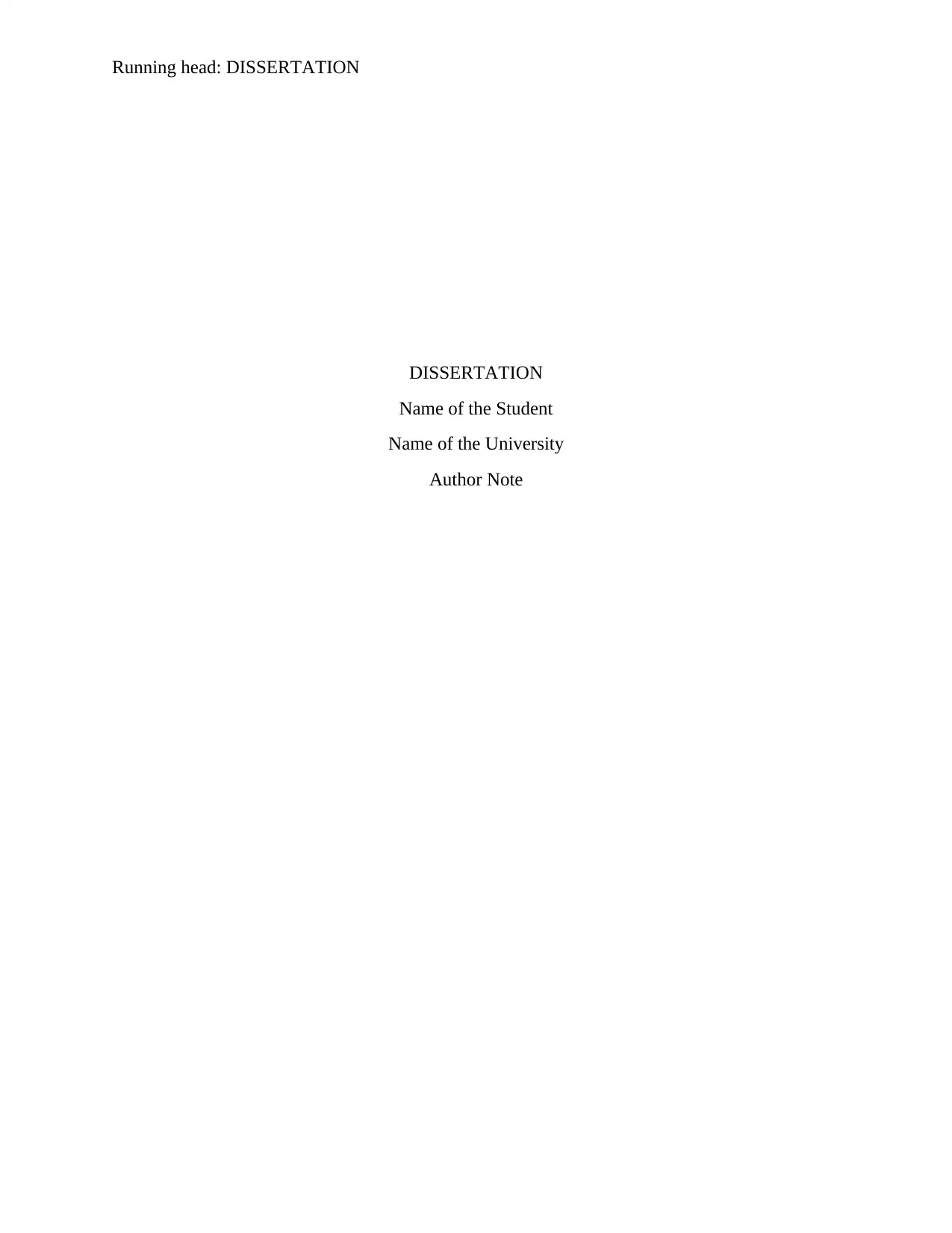
Running head: DISSERTATION
DISSERTATION
Name of the Student
Name of the University
Author Note
DISSERTATION
Name of the Student
Name of the University
Author Note
Paraphrase This Document
Need a fresh take? Get an instant paraphrase of this document with our AI Paraphraser
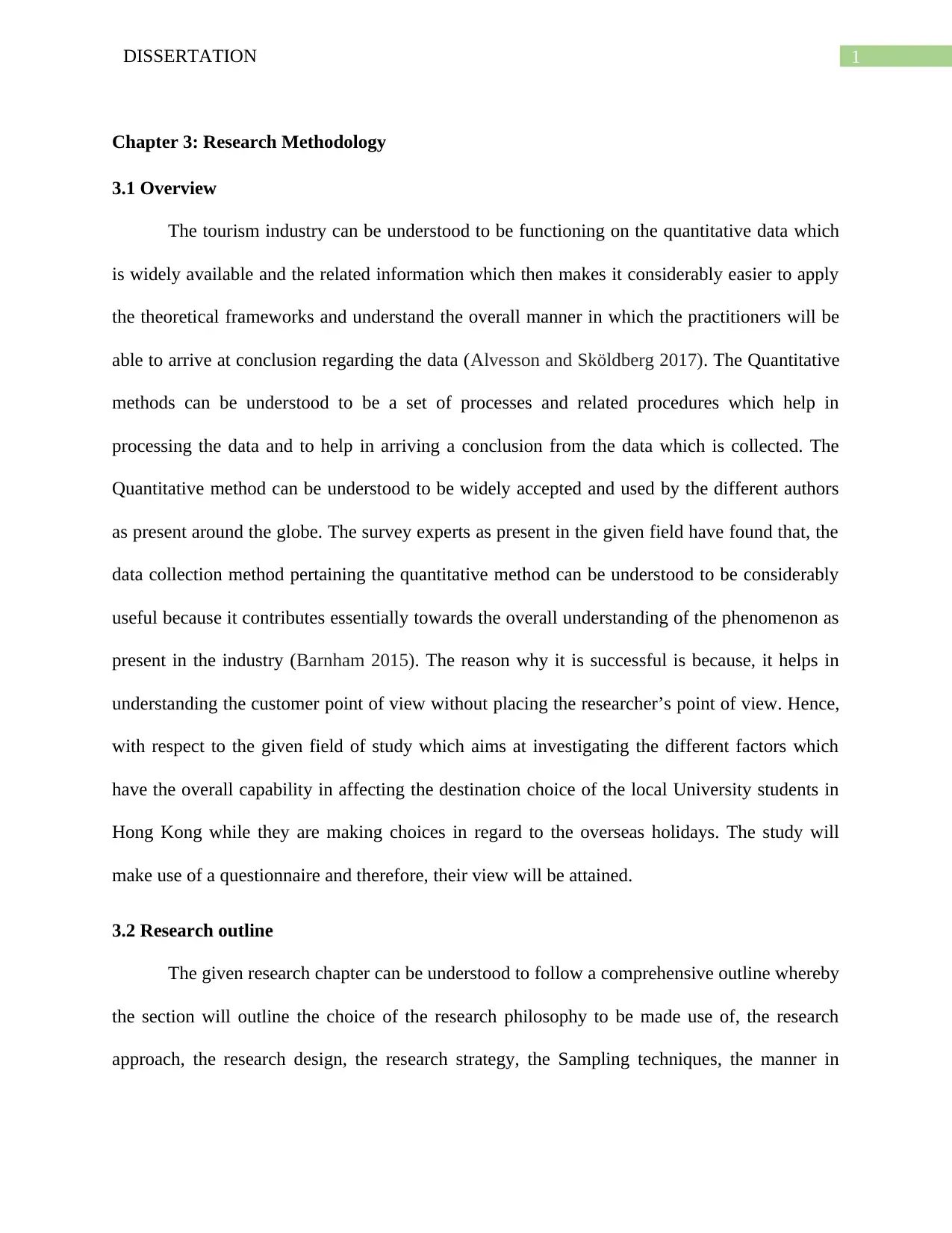
1DISSERTATION
Chapter 3: Research Methodology
3.1 Overview
The tourism industry can be understood to be functioning on the quantitative data which
is widely available and the related information which then makes it considerably easier to apply
the theoretical frameworks and understand the overall manner in which the practitioners will be
able to arrive at conclusion regarding the data (Alvesson and Sköldberg 2017). The Quantitative
methods can be understood to be a set of processes and related procedures which help in
processing the data and to help in arriving a conclusion from the data which is collected. The
Quantitative method can be understood to be widely accepted and used by the different authors
as present around the globe. The survey experts as present in the given field have found that, the
data collection method pertaining the quantitative method can be understood to be considerably
useful because it contributes essentially towards the overall understanding of the phenomenon as
present in the industry (Barnham 2015). The reason why it is successful is because, it helps in
understanding the customer point of view without placing the researcher’s point of view. Hence,
with respect to the given field of study which aims at investigating the different factors which
have the overall capability in affecting the destination choice of the local University students in
Hong Kong while they are making choices in regard to the overseas holidays. The study will
make use of a questionnaire and therefore, their view will be attained.
3.2 Research outline
The given research chapter can be understood to follow a comprehensive outline whereby
the section will outline the choice of the research philosophy to be made use of, the research
approach, the research design, the research strategy, the Sampling techniques, the manner in
Chapter 3: Research Methodology
3.1 Overview
The tourism industry can be understood to be functioning on the quantitative data which
is widely available and the related information which then makes it considerably easier to apply
the theoretical frameworks and understand the overall manner in which the practitioners will be
able to arrive at conclusion regarding the data (Alvesson and Sköldberg 2017). The Quantitative
methods can be understood to be a set of processes and related procedures which help in
processing the data and to help in arriving a conclusion from the data which is collected. The
Quantitative method can be understood to be widely accepted and used by the different authors
as present around the globe. The survey experts as present in the given field have found that, the
data collection method pertaining the quantitative method can be understood to be considerably
useful because it contributes essentially towards the overall understanding of the phenomenon as
present in the industry (Barnham 2015). The reason why it is successful is because, it helps in
understanding the customer point of view without placing the researcher’s point of view. Hence,
with respect to the given field of study which aims at investigating the different factors which
have the overall capability in affecting the destination choice of the local University students in
Hong Kong while they are making choices in regard to the overseas holidays. The study will
make use of a questionnaire and therefore, their view will be attained.
3.2 Research outline
The given research chapter can be understood to follow a comprehensive outline whereby
the section will outline the choice of the research philosophy to be made use of, the research
approach, the research design, the research strategy, the Sampling techniques, the manner in
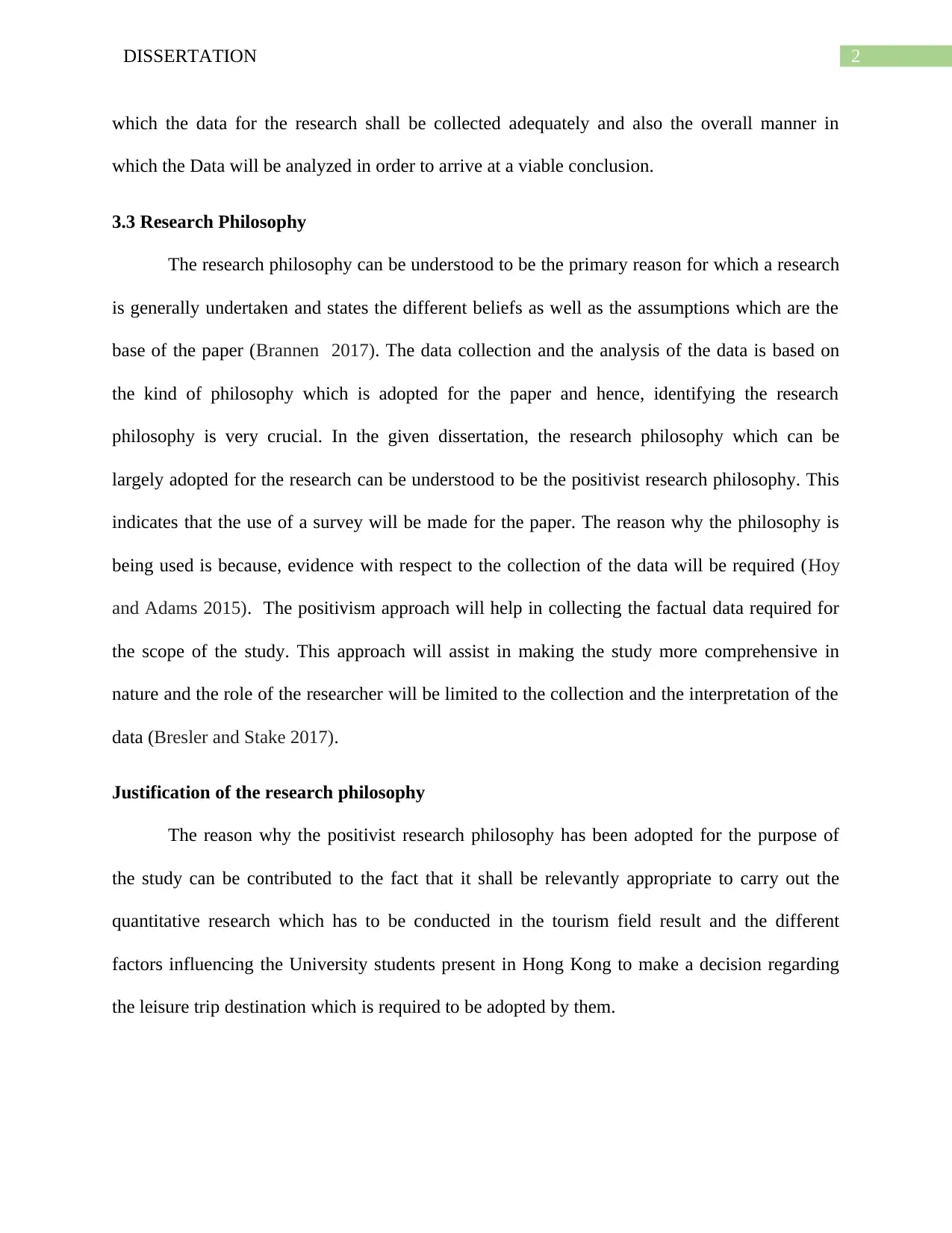
2DISSERTATION
which the data for the research shall be collected adequately and also the overall manner in
which the Data will be analyzed in order to arrive at a viable conclusion.
3.3 Research Philosophy
The research philosophy can be understood to be the primary reason for which a research
is generally undertaken and states the different beliefs as well as the assumptions which are the
base of the paper (Brannen 2017). The data collection and the analysis of the data is based on
the kind of philosophy which is adopted for the paper and hence, identifying the research
philosophy is very crucial. In the given dissertation, the research philosophy which can be
largely adopted for the research can be understood to be the positivist research philosophy. This
indicates that the use of a survey will be made for the paper. The reason why the philosophy is
being used is because, evidence with respect to the collection of the data will be required (Hoy
and Adams 2015). The positivism approach will help in collecting the factual data required for
the scope of the study. This approach will assist in making the study more comprehensive in
nature and the role of the researcher will be limited to the collection and the interpretation of the
data (Bresler and Stake 2017).
Justification of the research philosophy
The reason why the positivist research philosophy has been adopted for the purpose of
the study can be contributed to the fact that it shall be relevantly appropriate to carry out the
quantitative research which has to be conducted in the tourism field result and the different
factors influencing the University students present in Hong Kong to make a decision regarding
the leisure trip destination which is required to be adopted by them.
which the data for the research shall be collected adequately and also the overall manner in
which the Data will be analyzed in order to arrive at a viable conclusion.
3.3 Research Philosophy
The research philosophy can be understood to be the primary reason for which a research
is generally undertaken and states the different beliefs as well as the assumptions which are the
base of the paper (Brannen 2017). The data collection and the analysis of the data is based on
the kind of philosophy which is adopted for the paper and hence, identifying the research
philosophy is very crucial. In the given dissertation, the research philosophy which can be
largely adopted for the research can be understood to be the positivist research philosophy. This
indicates that the use of a survey will be made for the paper. The reason why the philosophy is
being used is because, evidence with respect to the collection of the data will be required (Hoy
and Adams 2015). The positivism approach will help in collecting the factual data required for
the scope of the study. This approach will assist in making the study more comprehensive in
nature and the role of the researcher will be limited to the collection and the interpretation of the
data (Bresler and Stake 2017).
Justification of the research philosophy
The reason why the positivist research philosophy has been adopted for the purpose of
the study can be contributed to the fact that it shall be relevantly appropriate to carry out the
quantitative research which has to be conducted in the tourism field result and the different
factors influencing the University students present in Hong Kong to make a decision regarding
the leisure trip destination which is required to be adopted by them.
⊘ This is a preview!⊘
Do you want full access?
Subscribe today to unlock all pages.

Trusted by 1+ million students worldwide
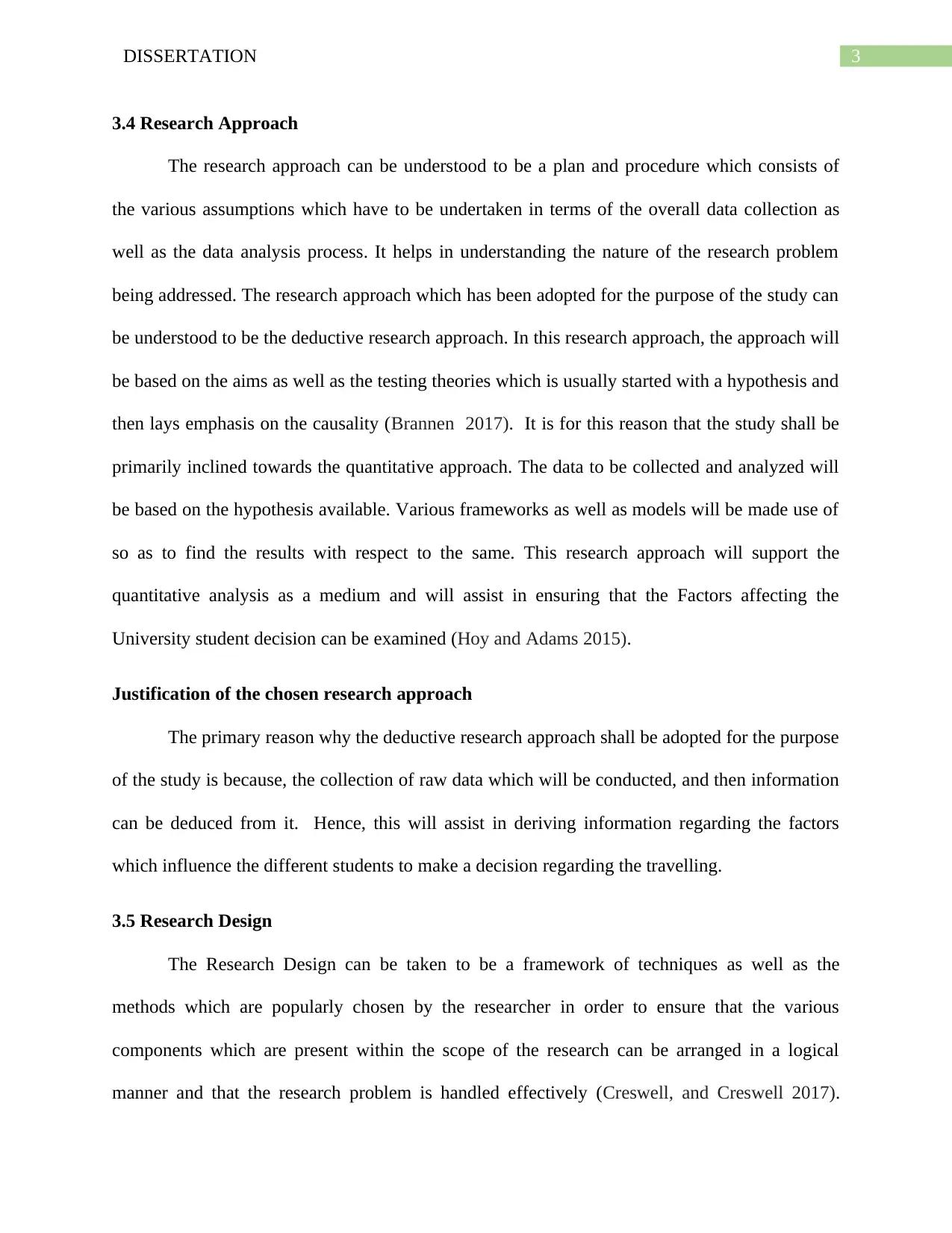
3DISSERTATION
3.4 Research Approach
The research approach can be understood to be a plan and procedure which consists of
the various assumptions which have to be undertaken in terms of the overall data collection as
well as the data analysis process. It helps in understanding the nature of the research problem
being addressed. The research approach which has been adopted for the purpose of the study can
be understood to be the deductive research approach. In this research approach, the approach will
be based on the aims as well as the testing theories which is usually started with a hypothesis and
then lays emphasis on the causality (Brannen 2017). It is for this reason that the study shall be
primarily inclined towards the quantitative approach. The data to be collected and analyzed will
be based on the hypothesis available. Various frameworks as well as models will be made use of
so as to find the results with respect to the same. This research approach will support the
quantitative analysis as a medium and will assist in ensuring that the Factors affecting the
University student decision can be examined (Hoy and Adams 2015).
Justification of the chosen research approach
The primary reason why the deductive research approach shall be adopted for the purpose
of the study is because, the collection of raw data which will be conducted, and then information
can be deduced from it. Hence, this will assist in deriving information regarding the factors
which influence the different students to make a decision regarding the travelling.
3.5 Research Design
The Research Design can be taken to be a framework of techniques as well as the
methods which are popularly chosen by the researcher in order to ensure that the various
components which are present within the scope of the research can be arranged in a logical
manner and that the research problem is handled effectively (Creswell, and Creswell 2017).
3.4 Research Approach
The research approach can be understood to be a plan and procedure which consists of
the various assumptions which have to be undertaken in terms of the overall data collection as
well as the data analysis process. It helps in understanding the nature of the research problem
being addressed. The research approach which has been adopted for the purpose of the study can
be understood to be the deductive research approach. In this research approach, the approach will
be based on the aims as well as the testing theories which is usually started with a hypothesis and
then lays emphasis on the causality (Brannen 2017). It is for this reason that the study shall be
primarily inclined towards the quantitative approach. The data to be collected and analyzed will
be based on the hypothesis available. Various frameworks as well as models will be made use of
so as to find the results with respect to the same. This research approach will support the
quantitative analysis as a medium and will assist in ensuring that the Factors affecting the
University student decision can be examined (Hoy and Adams 2015).
Justification of the chosen research approach
The primary reason why the deductive research approach shall be adopted for the purpose
of the study is because, the collection of raw data which will be conducted, and then information
can be deduced from it. Hence, this will assist in deriving information regarding the factors
which influence the different students to make a decision regarding the travelling.
3.5 Research Design
The Research Design can be taken to be a framework of techniques as well as the
methods which are popularly chosen by the researcher in order to ensure that the various
components which are present within the scope of the research can be arranged in a logical
manner and that the research problem is handled effectively (Creswell, and Creswell 2017).
Paraphrase This Document
Need a fresh take? Get an instant paraphrase of this document with our AI Paraphraser
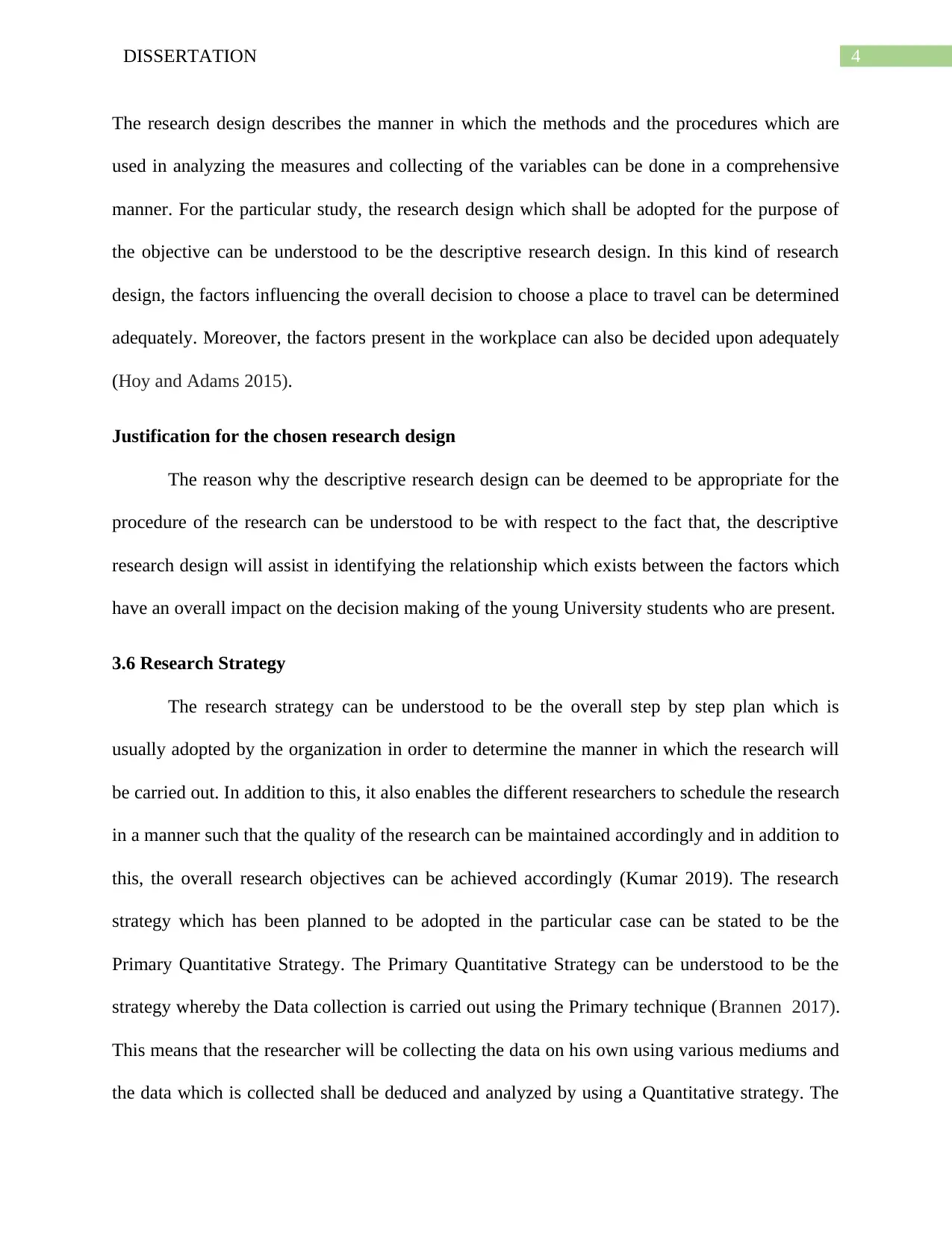
4DISSERTATION
The research design describes the manner in which the methods and the procedures which are
used in analyzing the measures and collecting of the variables can be done in a comprehensive
manner. For the particular study, the research design which shall be adopted for the purpose of
the objective can be understood to be the descriptive research design. In this kind of research
design, the factors influencing the overall decision to choose a place to travel can be determined
adequately. Moreover, the factors present in the workplace can also be decided upon adequately
(Hoy and Adams 2015).
Justification for the chosen research design
The reason why the descriptive research design can be deemed to be appropriate for the
procedure of the research can be understood to be with respect to the fact that, the descriptive
research design will assist in identifying the relationship which exists between the factors which
have an overall impact on the decision making of the young University students who are present.
3.6 Research Strategy
The research strategy can be understood to be the overall step by step plan which is
usually adopted by the organization in order to determine the manner in which the research will
be carried out. In addition to this, it also enables the different researchers to schedule the research
in a manner such that the quality of the research can be maintained accordingly and in addition to
this, the overall research objectives can be achieved accordingly (Kumar 2019). The research
strategy which has been planned to be adopted in the particular case can be stated to be the
Primary Quantitative Strategy. The Primary Quantitative Strategy can be understood to be the
strategy whereby the Data collection is carried out using the Primary technique (Brannen 2017).
This means that the researcher will be collecting the data on his own using various mediums and
the data which is collected shall be deduced and analyzed by using a Quantitative strategy. The
The research design describes the manner in which the methods and the procedures which are
used in analyzing the measures and collecting of the variables can be done in a comprehensive
manner. For the particular study, the research design which shall be adopted for the purpose of
the objective can be understood to be the descriptive research design. In this kind of research
design, the factors influencing the overall decision to choose a place to travel can be determined
adequately. Moreover, the factors present in the workplace can also be decided upon adequately
(Hoy and Adams 2015).
Justification for the chosen research design
The reason why the descriptive research design can be deemed to be appropriate for the
procedure of the research can be understood to be with respect to the fact that, the descriptive
research design will assist in identifying the relationship which exists between the factors which
have an overall impact on the decision making of the young University students who are present.
3.6 Research Strategy
The research strategy can be understood to be the overall step by step plan which is
usually adopted by the organization in order to determine the manner in which the research will
be carried out. In addition to this, it also enables the different researchers to schedule the research
in a manner such that the quality of the research can be maintained accordingly and in addition to
this, the overall research objectives can be achieved accordingly (Kumar 2019). The research
strategy which has been planned to be adopted in the particular case can be stated to be the
Primary Quantitative Strategy. The Primary Quantitative Strategy can be understood to be the
strategy whereby the Data collection is carried out using the Primary technique (Brannen 2017).
This means that the researcher will be collecting the data on his own using various mediums and
the data which is collected shall be deduced and analyzed by using a Quantitative strategy. The
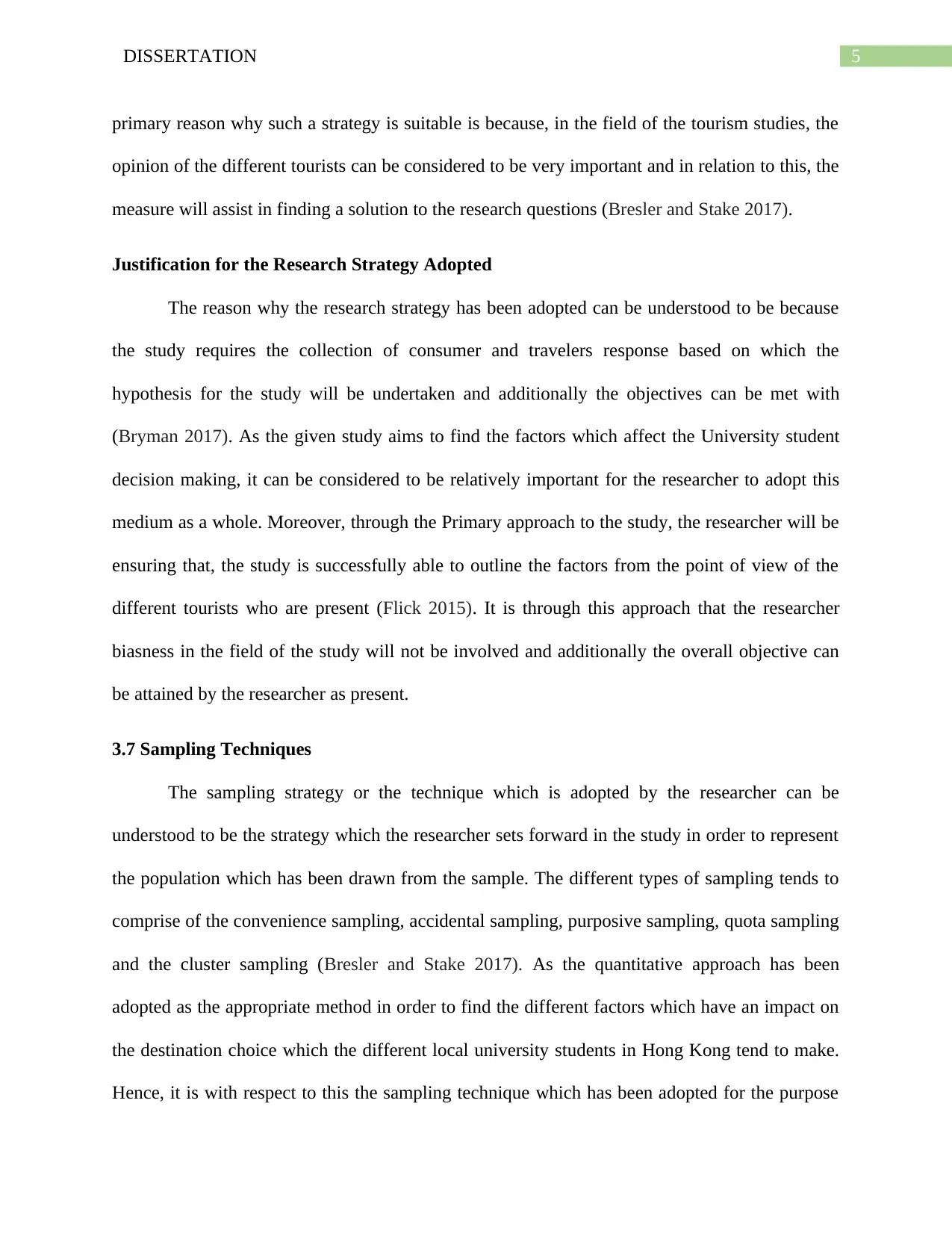
5DISSERTATION
primary reason why such a strategy is suitable is because, in the field of the tourism studies, the
opinion of the different tourists can be considered to be very important and in relation to this, the
measure will assist in finding a solution to the research questions (Bresler and Stake 2017).
Justification for the Research Strategy Adopted
The reason why the research strategy has been adopted can be understood to be because
the study requires the collection of consumer and travelers response based on which the
hypothesis for the study will be undertaken and additionally the objectives can be met with
(Bryman 2017). As the given study aims to find the factors which affect the University student
decision making, it can be considered to be relatively important for the researcher to adopt this
medium as a whole. Moreover, through the Primary approach to the study, the researcher will be
ensuring that, the study is successfully able to outline the factors from the point of view of the
different tourists who are present (Flick 2015). It is through this approach that the researcher
biasness in the field of the study will not be involved and additionally the overall objective can
be attained by the researcher as present.
3.7 Sampling Techniques
The sampling strategy or the technique which is adopted by the researcher can be
understood to be the strategy which the researcher sets forward in the study in order to represent
the population which has been drawn from the sample. The different types of sampling tends to
comprise of the convenience sampling, accidental sampling, purposive sampling, quota sampling
and the cluster sampling (Bresler and Stake 2017). As the quantitative approach has been
adopted as the appropriate method in order to find the different factors which have an impact on
the destination choice which the different local university students in Hong Kong tend to make.
Hence, it is with respect to this the sampling technique which has been adopted for the purpose
primary reason why such a strategy is suitable is because, in the field of the tourism studies, the
opinion of the different tourists can be considered to be very important and in relation to this, the
measure will assist in finding a solution to the research questions (Bresler and Stake 2017).
Justification for the Research Strategy Adopted
The reason why the research strategy has been adopted can be understood to be because
the study requires the collection of consumer and travelers response based on which the
hypothesis for the study will be undertaken and additionally the objectives can be met with
(Bryman 2017). As the given study aims to find the factors which affect the University student
decision making, it can be considered to be relatively important for the researcher to adopt this
medium as a whole. Moreover, through the Primary approach to the study, the researcher will be
ensuring that, the study is successfully able to outline the factors from the point of view of the
different tourists who are present (Flick 2015). It is through this approach that the researcher
biasness in the field of the study will not be involved and additionally the overall objective can
be attained by the researcher as present.
3.7 Sampling Techniques
The sampling strategy or the technique which is adopted by the researcher can be
understood to be the strategy which the researcher sets forward in the study in order to represent
the population which has been drawn from the sample. The different types of sampling tends to
comprise of the convenience sampling, accidental sampling, purposive sampling, quota sampling
and the cluster sampling (Bresler and Stake 2017). As the quantitative approach has been
adopted as the appropriate method in order to find the different factors which have an impact on
the destination choice which the different local university students in Hong Kong tend to make.
Hence, it is with respect to this the sampling technique which has been adopted for the purpose
⊘ This is a preview!⊘
Do you want full access?
Subscribe today to unlock all pages.

Trusted by 1+ million students worldwide
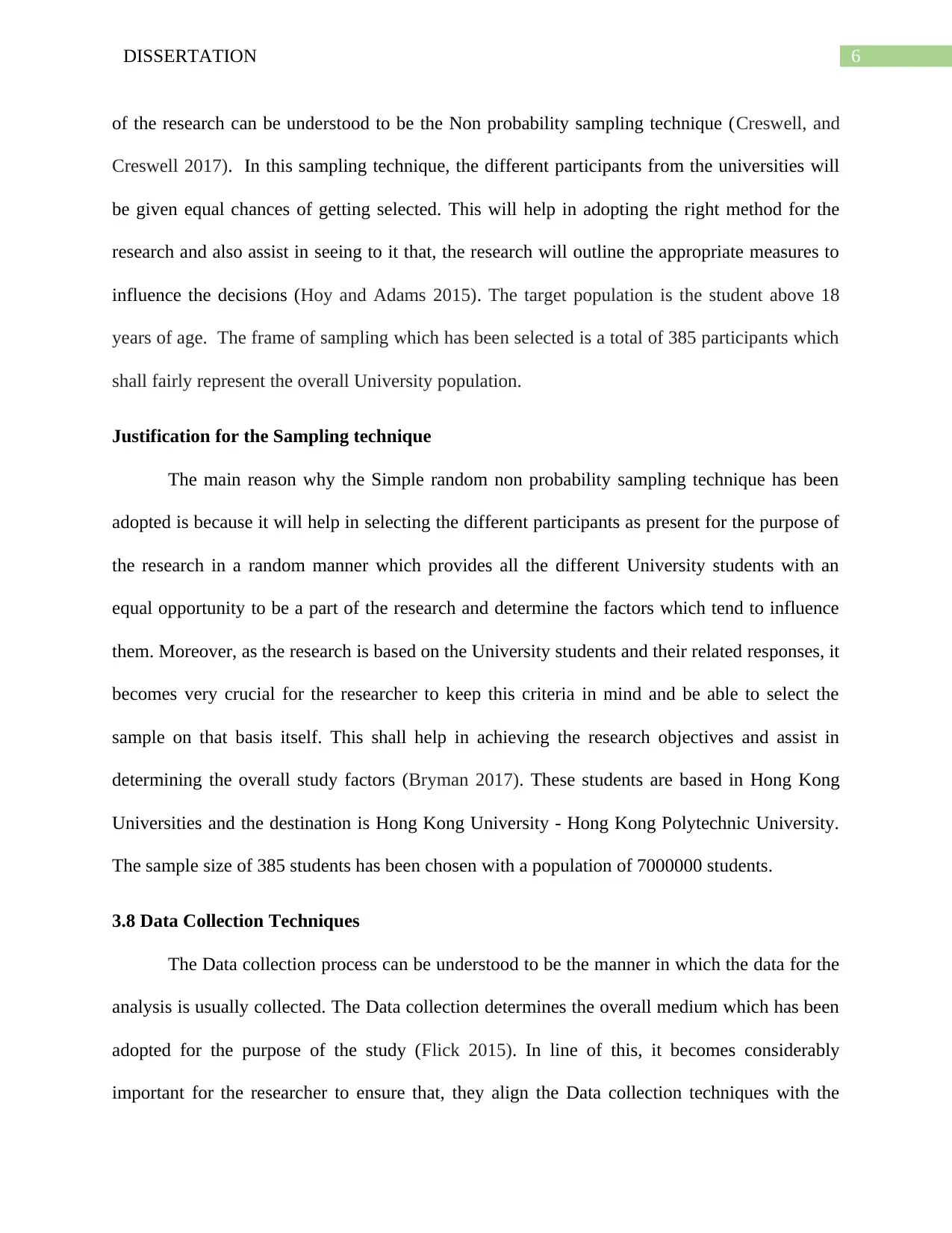
6DISSERTATION
of the research can be understood to be the Non probability sampling technique (Creswell, and
Creswell 2017). In this sampling technique, the different participants from the universities will
be given equal chances of getting selected. This will help in adopting the right method for the
research and also assist in seeing to it that, the research will outline the appropriate measures to
influence the decisions (Hoy and Adams 2015). The target population is the student above 18
years of age. The frame of sampling which has been selected is a total of 385 participants which
shall fairly represent the overall University population.
Justification for the Sampling technique
The main reason why the Simple random non probability sampling technique has been
adopted is because it will help in selecting the different participants as present for the purpose of
the research in a random manner which provides all the different University students with an
equal opportunity to be a part of the research and determine the factors which tend to influence
them. Moreover, as the research is based on the University students and their related responses, it
becomes very crucial for the researcher to keep this criteria in mind and be able to select the
sample on that basis itself. This shall help in achieving the research objectives and assist in
determining the overall study factors (Bryman 2017). These students are based in Hong Kong
Universities and the destination is Hong Kong University - Hong Kong Polytechnic University.
The sample size of 385 students has been chosen with a population of 7000000 students.
3.8 Data Collection Techniques
The Data collection process can be understood to be the manner in which the data for the
analysis is usually collected. The Data collection determines the overall medium which has been
adopted for the purpose of the study (Flick 2015). In line of this, it becomes considerably
important for the researcher to ensure that, they align the Data collection techniques with the
of the research can be understood to be the Non probability sampling technique (Creswell, and
Creswell 2017). In this sampling technique, the different participants from the universities will
be given equal chances of getting selected. This will help in adopting the right method for the
research and also assist in seeing to it that, the research will outline the appropriate measures to
influence the decisions (Hoy and Adams 2015). The target population is the student above 18
years of age. The frame of sampling which has been selected is a total of 385 participants which
shall fairly represent the overall University population.
Justification for the Sampling technique
The main reason why the Simple random non probability sampling technique has been
adopted is because it will help in selecting the different participants as present for the purpose of
the research in a random manner which provides all the different University students with an
equal opportunity to be a part of the research and determine the factors which tend to influence
them. Moreover, as the research is based on the University students and their related responses, it
becomes very crucial for the researcher to keep this criteria in mind and be able to select the
sample on that basis itself. This shall help in achieving the research objectives and assist in
determining the overall study factors (Bryman 2017). These students are based in Hong Kong
Universities and the destination is Hong Kong University - Hong Kong Polytechnic University.
The sample size of 385 students has been chosen with a population of 7000000 students.
3.8 Data Collection Techniques
The Data collection process can be understood to be the manner in which the data for the
analysis is usually collected. The Data collection determines the overall medium which has been
adopted for the purpose of the study (Flick 2015). In line of this, it becomes considerably
important for the researcher to ensure that, they align the Data collection techniques with the
Paraphrase This Document
Need a fresh take? Get an instant paraphrase of this document with our AI Paraphraser
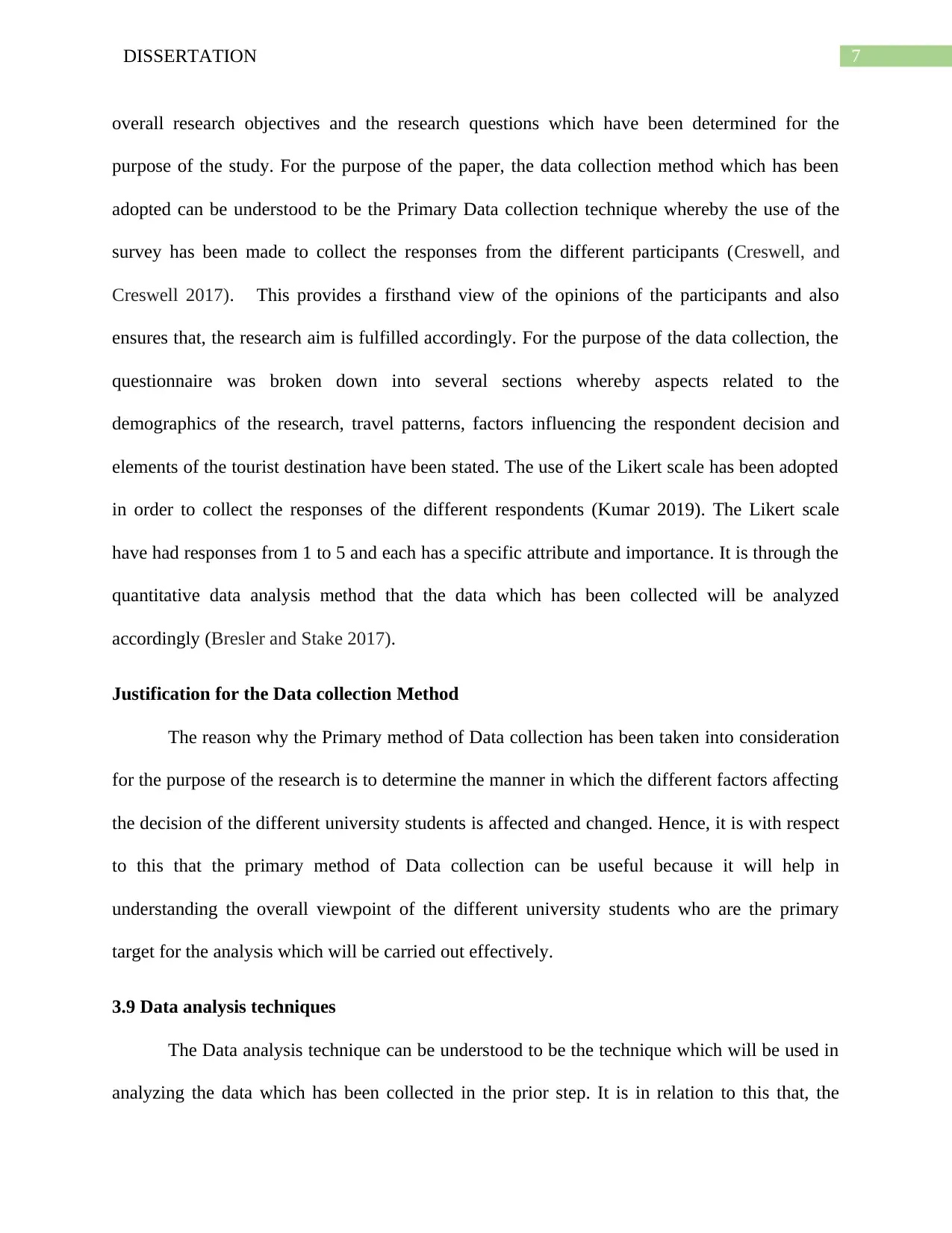
7DISSERTATION
overall research objectives and the research questions which have been determined for the
purpose of the study. For the purpose of the paper, the data collection method which has been
adopted can be understood to be the Primary Data collection technique whereby the use of the
survey has been made to collect the responses from the different participants (Creswell, and
Creswell 2017). This provides a firsthand view of the opinions of the participants and also
ensures that, the research aim is fulfilled accordingly. For the purpose of the data collection, the
questionnaire was broken down into several sections whereby aspects related to the
demographics of the research, travel patterns, factors influencing the respondent decision and
elements of the tourist destination have been stated. The use of the Likert scale has been adopted
in order to collect the responses of the different respondents (Kumar 2019). The Likert scale
have had responses from 1 to 5 and each has a specific attribute and importance. It is through the
quantitative data analysis method that the data which has been collected will be analyzed
accordingly (Bresler and Stake 2017).
Justification for the Data collection Method
The reason why the Primary method of Data collection has been taken into consideration
for the purpose of the research is to determine the manner in which the different factors affecting
the decision of the different university students is affected and changed. Hence, it is with respect
to this that the primary method of Data collection can be useful because it will help in
understanding the overall viewpoint of the different university students who are the primary
target for the analysis which will be carried out effectively.
3.9 Data analysis techniques
The Data analysis technique can be understood to be the technique which will be used in
analyzing the data which has been collected in the prior step. It is in relation to this that, the
overall research objectives and the research questions which have been determined for the
purpose of the study. For the purpose of the paper, the data collection method which has been
adopted can be understood to be the Primary Data collection technique whereby the use of the
survey has been made to collect the responses from the different participants (Creswell, and
Creswell 2017). This provides a firsthand view of the opinions of the participants and also
ensures that, the research aim is fulfilled accordingly. For the purpose of the data collection, the
questionnaire was broken down into several sections whereby aspects related to the
demographics of the research, travel patterns, factors influencing the respondent decision and
elements of the tourist destination have been stated. The use of the Likert scale has been adopted
in order to collect the responses of the different respondents (Kumar 2019). The Likert scale
have had responses from 1 to 5 and each has a specific attribute and importance. It is through the
quantitative data analysis method that the data which has been collected will be analyzed
accordingly (Bresler and Stake 2017).
Justification for the Data collection Method
The reason why the Primary method of Data collection has been taken into consideration
for the purpose of the research is to determine the manner in which the different factors affecting
the decision of the different university students is affected and changed. Hence, it is with respect
to this that the primary method of Data collection can be useful because it will help in
understanding the overall viewpoint of the different university students who are the primary
target for the analysis which will be carried out effectively.
3.9 Data analysis techniques
The Data analysis technique can be understood to be the technique which will be used in
analyzing the data which has been collected in the prior step. It is in relation to this that, the
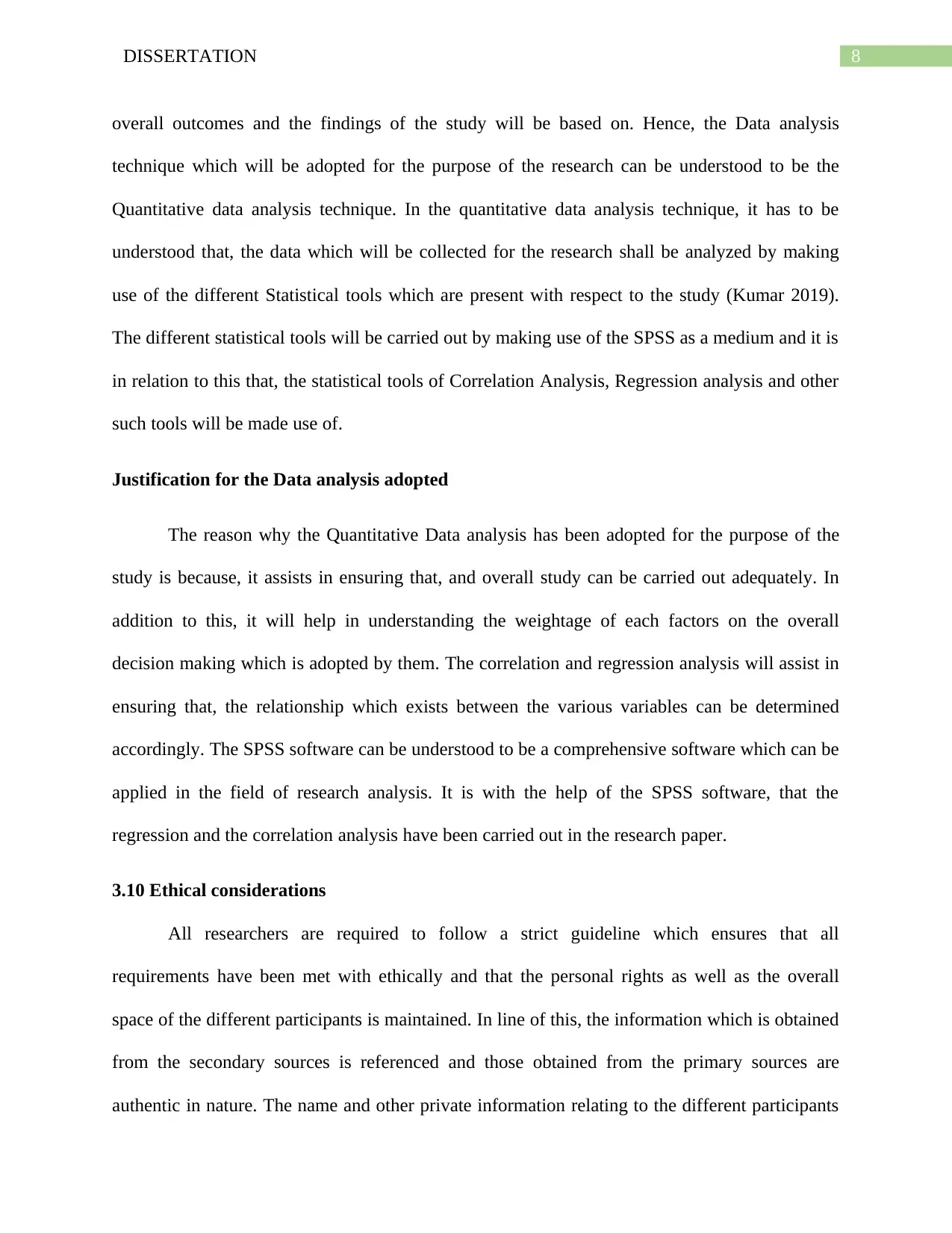
8DISSERTATION
overall outcomes and the findings of the study will be based on. Hence, the Data analysis
technique which will be adopted for the purpose of the research can be understood to be the
Quantitative data analysis technique. In the quantitative data analysis technique, it has to be
understood that, the data which will be collected for the research shall be analyzed by making
use of the different Statistical tools which are present with respect to the study (Kumar 2019).
The different statistical tools will be carried out by making use of the SPSS as a medium and it is
in relation to this that, the statistical tools of Correlation Analysis, Regression analysis and other
such tools will be made use of.
Justification for the Data analysis adopted
The reason why the Quantitative Data analysis has been adopted for the purpose of the
study is because, it assists in ensuring that, and overall study can be carried out adequately. In
addition to this, it will help in understanding the weightage of each factors on the overall
decision making which is adopted by them. The correlation and regression analysis will assist in
ensuring that, the relationship which exists between the various variables can be determined
accordingly. The SPSS software can be understood to be a comprehensive software which can be
applied in the field of research analysis. It is with the help of the SPSS software, that the
regression and the correlation analysis have been carried out in the research paper.
3.10 Ethical considerations
All researchers are required to follow a strict guideline which ensures that all
requirements have been met with ethically and that the personal rights as well as the overall
space of the different participants is maintained. In line of this, the information which is obtained
from the secondary sources is referenced and those obtained from the primary sources are
authentic in nature. The name and other private information relating to the different participants
overall outcomes and the findings of the study will be based on. Hence, the Data analysis
technique which will be adopted for the purpose of the research can be understood to be the
Quantitative data analysis technique. In the quantitative data analysis technique, it has to be
understood that, the data which will be collected for the research shall be analyzed by making
use of the different Statistical tools which are present with respect to the study (Kumar 2019).
The different statistical tools will be carried out by making use of the SPSS as a medium and it is
in relation to this that, the statistical tools of Correlation Analysis, Regression analysis and other
such tools will be made use of.
Justification for the Data analysis adopted
The reason why the Quantitative Data analysis has been adopted for the purpose of the
study is because, it assists in ensuring that, and overall study can be carried out adequately. In
addition to this, it will help in understanding the weightage of each factors on the overall
decision making which is adopted by them. The correlation and regression analysis will assist in
ensuring that, the relationship which exists between the various variables can be determined
accordingly. The SPSS software can be understood to be a comprehensive software which can be
applied in the field of research analysis. It is with the help of the SPSS software, that the
regression and the correlation analysis have been carried out in the research paper.
3.10 Ethical considerations
All researchers are required to follow a strict guideline which ensures that all
requirements have been met with ethically and that the personal rights as well as the overall
space of the different participants is maintained. In line of this, the information which is obtained
from the secondary sources is referenced and those obtained from the primary sources are
authentic in nature. The name and other private information relating to the different participants
⊘ This is a preview!⊘
Do you want full access?
Subscribe today to unlock all pages.

Trusted by 1+ million students worldwide
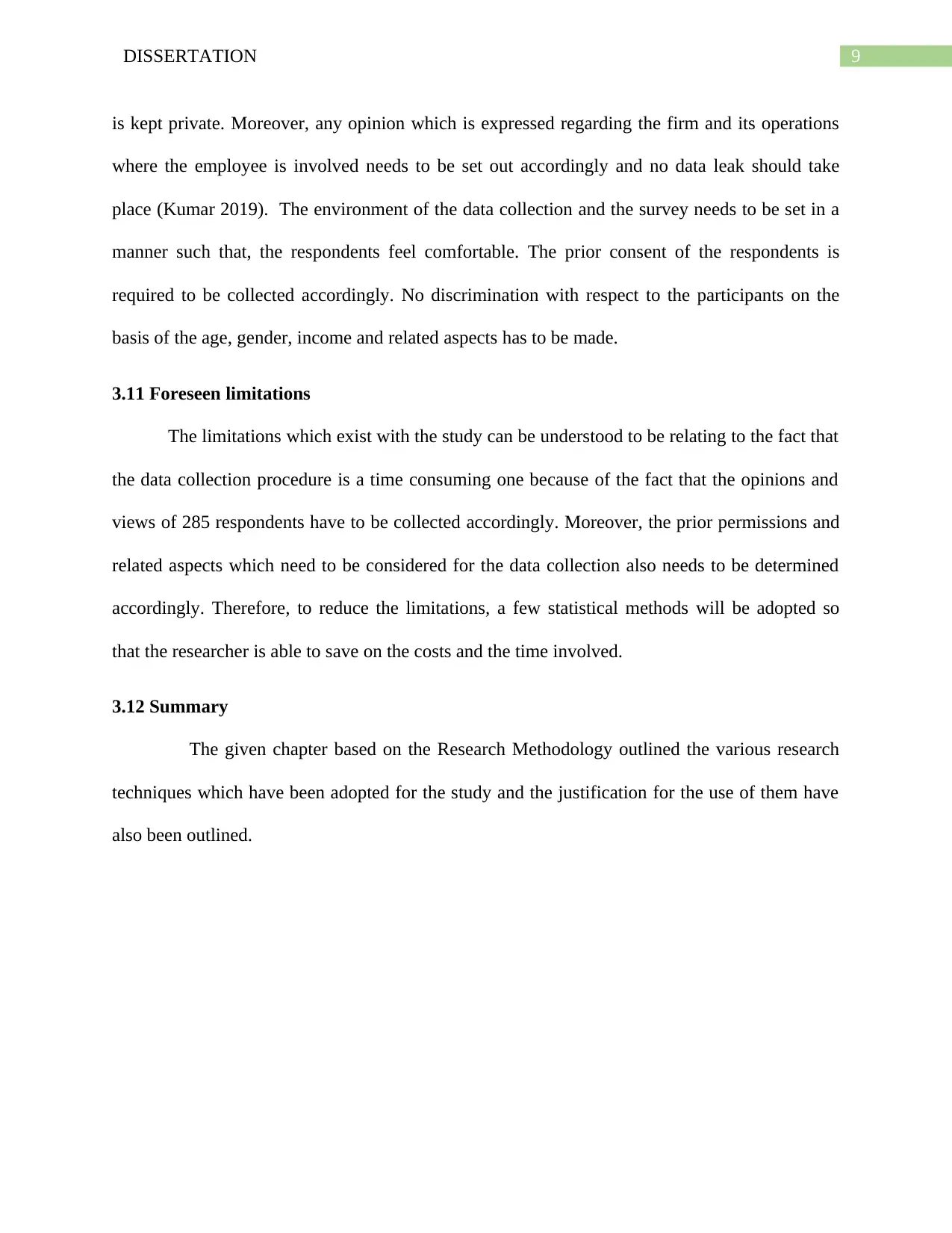
9DISSERTATION
is kept private. Moreover, any opinion which is expressed regarding the firm and its operations
where the employee is involved needs to be set out accordingly and no data leak should take
place (Kumar 2019). The environment of the data collection and the survey needs to be set in a
manner such that, the respondents feel comfortable. The prior consent of the respondents is
required to be collected accordingly. No discrimination with respect to the participants on the
basis of the age, gender, income and related aspects has to be made.
3.11 Foreseen limitations
The limitations which exist with the study can be understood to be relating to the fact that
the data collection procedure is a time consuming one because of the fact that the opinions and
views of 285 respondents have to be collected accordingly. Moreover, the prior permissions and
related aspects which need to be considered for the data collection also needs to be determined
accordingly. Therefore, to reduce the limitations, a few statistical methods will be adopted so
that the researcher is able to save on the costs and the time involved.
3.12 Summary
The given chapter based on the Research Methodology outlined the various research
techniques which have been adopted for the study and the justification for the use of them have
also been outlined.
is kept private. Moreover, any opinion which is expressed regarding the firm and its operations
where the employee is involved needs to be set out accordingly and no data leak should take
place (Kumar 2019). The environment of the data collection and the survey needs to be set in a
manner such that, the respondents feel comfortable. The prior consent of the respondents is
required to be collected accordingly. No discrimination with respect to the participants on the
basis of the age, gender, income and related aspects has to be made.
3.11 Foreseen limitations
The limitations which exist with the study can be understood to be relating to the fact that
the data collection procedure is a time consuming one because of the fact that the opinions and
views of 285 respondents have to be collected accordingly. Moreover, the prior permissions and
related aspects which need to be considered for the data collection also needs to be determined
accordingly. Therefore, to reduce the limitations, a few statistical methods will be adopted so
that the researcher is able to save on the costs and the time involved.
3.12 Summary
The given chapter based on the Research Methodology outlined the various research
techniques which have been adopted for the study and the justification for the use of them have
also been outlined.
Paraphrase This Document
Need a fresh take? Get an instant paraphrase of this document with our AI Paraphraser
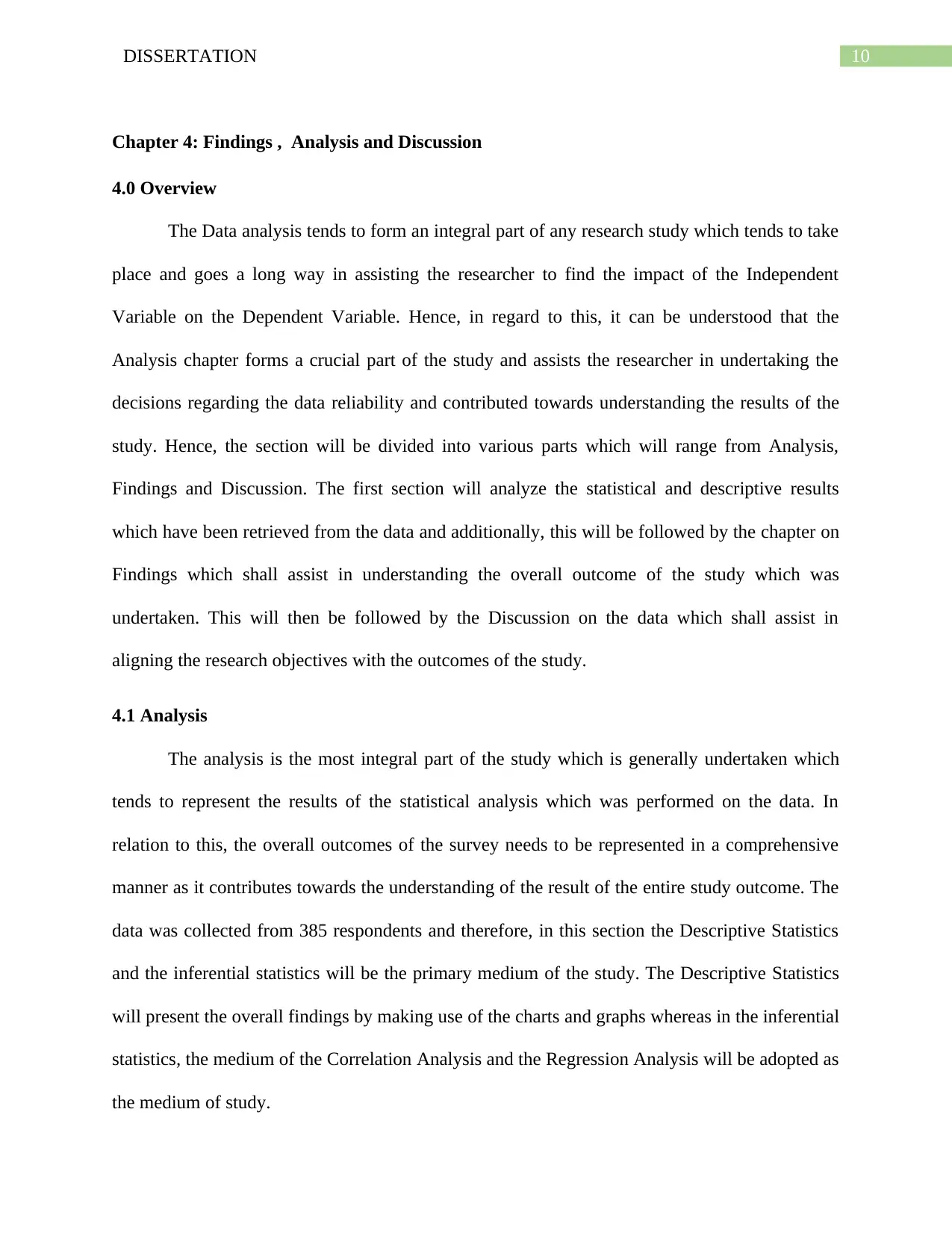
10DISSERTATION
Chapter 4: Findings , Analysis and Discussion
4.0 Overview
The Data analysis tends to form an integral part of any research study which tends to take
place and goes a long way in assisting the researcher to find the impact of the Independent
Variable on the Dependent Variable. Hence, in regard to this, it can be understood that the
Analysis chapter forms a crucial part of the study and assists the researcher in undertaking the
decisions regarding the data reliability and contributed towards understanding the results of the
study. Hence, the section will be divided into various parts which will range from Analysis,
Findings and Discussion. The first section will analyze the statistical and descriptive results
which have been retrieved from the data and additionally, this will be followed by the chapter on
Findings which shall assist in understanding the overall outcome of the study which was
undertaken. This will then be followed by the Discussion on the data which shall assist in
aligning the research objectives with the outcomes of the study.
4.1 Analysis
The analysis is the most integral part of the study which is generally undertaken which
tends to represent the results of the statistical analysis which was performed on the data. In
relation to this, the overall outcomes of the survey needs to be represented in a comprehensive
manner as it contributes towards the understanding of the result of the entire study outcome. The
data was collected from 385 respondents and therefore, in this section the Descriptive Statistics
and the inferential statistics will be the primary medium of the study. The Descriptive Statistics
will present the overall findings by making use of the charts and graphs whereas in the inferential
statistics, the medium of the Correlation Analysis and the Regression Analysis will be adopted as
the medium of study.
Chapter 4: Findings , Analysis and Discussion
4.0 Overview
The Data analysis tends to form an integral part of any research study which tends to take
place and goes a long way in assisting the researcher to find the impact of the Independent
Variable on the Dependent Variable. Hence, in regard to this, it can be understood that the
Analysis chapter forms a crucial part of the study and assists the researcher in undertaking the
decisions regarding the data reliability and contributed towards understanding the results of the
study. Hence, the section will be divided into various parts which will range from Analysis,
Findings and Discussion. The first section will analyze the statistical and descriptive results
which have been retrieved from the data and additionally, this will be followed by the chapter on
Findings which shall assist in understanding the overall outcome of the study which was
undertaken. This will then be followed by the Discussion on the data which shall assist in
aligning the research objectives with the outcomes of the study.
4.1 Analysis
The analysis is the most integral part of the study which is generally undertaken which
tends to represent the results of the statistical analysis which was performed on the data. In
relation to this, the overall outcomes of the survey needs to be represented in a comprehensive
manner as it contributes towards the understanding of the result of the entire study outcome. The
data was collected from 385 respondents and therefore, in this section the Descriptive Statistics
and the inferential statistics will be the primary medium of the study. The Descriptive Statistics
will present the overall findings by making use of the charts and graphs whereas in the inferential
statistics, the medium of the Correlation Analysis and the Regression Analysis will be adopted as
the medium of study.
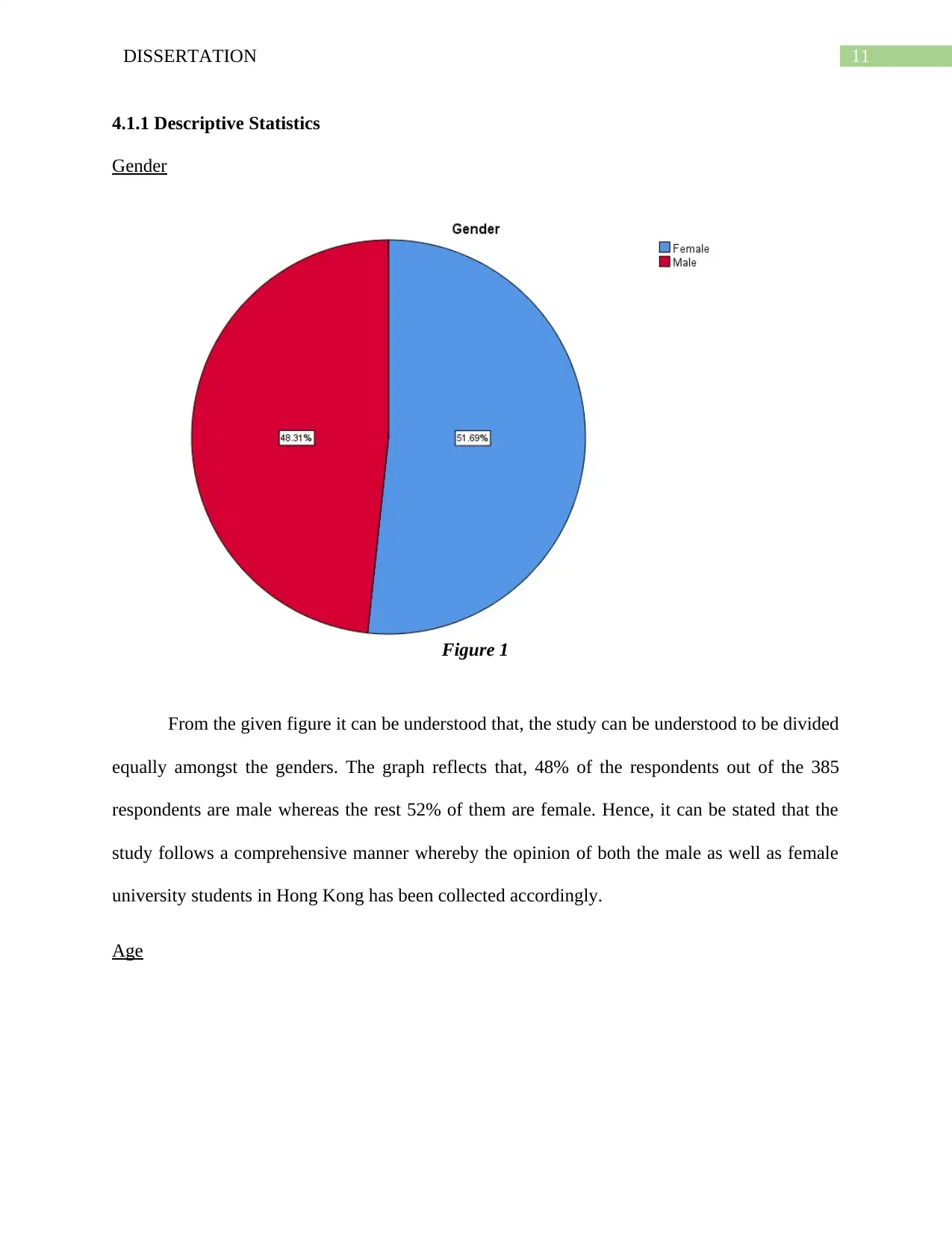
11DISSERTATION
4.1.1 Descriptive Statistics
Gender
Figure 1
From the given figure it can be understood that, the study can be understood to be divided
equally amongst the genders. The graph reflects that, 48% of the respondents out of the 385
respondents are male whereas the rest 52% of them are female. Hence, it can be stated that the
study follows a comprehensive manner whereby the opinion of both the male as well as female
university students in Hong Kong has been collected accordingly.
Age
4.1.1 Descriptive Statistics
Gender
Figure 1
From the given figure it can be understood that, the study can be understood to be divided
equally amongst the genders. The graph reflects that, 48% of the respondents out of the 385
respondents are male whereas the rest 52% of them are female. Hence, it can be stated that the
study follows a comprehensive manner whereby the opinion of both the male as well as female
university students in Hong Kong has been collected accordingly.
Age
⊘ This is a preview!⊘
Do you want full access?
Subscribe today to unlock all pages.

Trusted by 1+ million students worldwide
1 out of 74
Related Documents
Your All-in-One AI-Powered Toolkit for Academic Success.
+13062052269
info@desklib.com
Available 24*7 on WhatsApp / Email
![[object Object]](/_next/static/media/star-bottom.7253800d.svg)
Unlock your academic potential
Copyright © 2020–2025 A2Z Services. All Rights Reserved. Developed and managed by ZUCOL.





